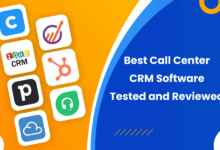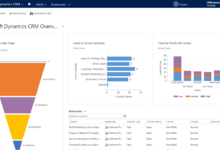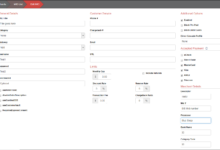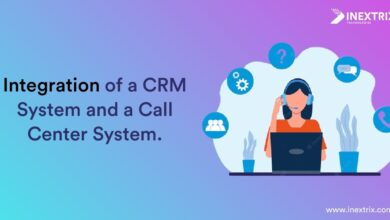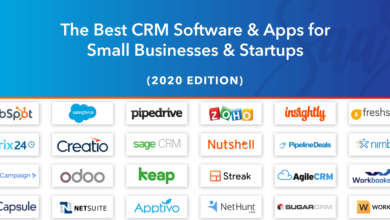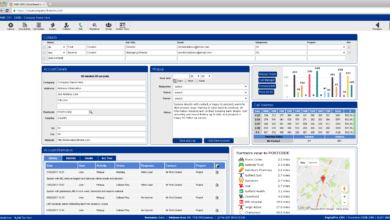CRM and Phone Integration: Streamlined Communication
CRM and phone integration represents a powerful synergy, transforming how businesses manage customer interactions and boost operational efficiency. By seamlessly connecting customer relationship management (CRM) software with phone systems, companies can streamline communication, improve data management, and ultimately enhance the customer experience. This integration allows for features like click-to-dial, call logging, and real-time data access, resulting in improved sales, enhanced customer service, and better team collaboration. The benefits extend to various business sizes and industries, offering a significant return on investment (ROI).
This exploration delves into the core functionalities of CRM and phone integration, examining the various types of integrations available, their implementation, and the advanced features that can significantly improve business processes. We will also consider the crucial aspects of choosing the right solution, ensuring data security, and optimizing scalability for sustainable growth. The ultimate goal is to provide a comprehensive understanding of how this integration can benefit your organization.
Defining CRM and Phone Integration
CRM and phone integration seamlessly merges customer relationship management (CRM) software with a business’s phone system, creating a unified platform for managing customer interactions. This integration streamlines workflows, improves communication efficiency, and provides valuable insights into customer behavior. The resulting synergy enhances customer service, boosts sales productivity, and contributes to overall business growth.
Core Functionalities of CRM Software
CRM software offers a range of functionalities designed to centralize and manage customer interactions. These core functionalities typically include contact management (storing and organizing customer information), lead management (tracking potential customers), sales management (managing sales processes and pipelines), marketing automation (automating marketing tasks), customer service management (managing customer support interactions), and reporting and analytics (providing insights into customer behavior and business performance). Robust CRM systems often integrate with other business applications, enhancing their capabilities and providing a holistic view of customer interactions.
Types of Phone Integrations Available for CRM Systems
Several types of phone integrations exist, each offering varying levels of functionality. These include:
- Click-to-call: This allows users to initiate calls directly from the CRM system with a single click on a customer’s contact information. This eliminates the need to manually dial numbers.
- Call logging: Automatically logs call details, such as date, time, duration, and caller ID, directly into the CRM system, providing a complete record of customer interactions.
- Call recording: Records calls for quality assurance, training purposes, or dispute resolution. This allows businesses to review interactions and identify areas for improvement.
- Screen pops: Displays customer information automatically on the screen when a call is received, allowing agents to access relevant data instantly and personalize interactions.
- Outbound dialing: Automates outbound calling processes, increasing efficiency and productivity for sales and marketing teams.
- Interactive Voice Response (IVR): Allows customers to navigate through a phone menu system to reach the appropriate department or agent, improving call routing efficiency.
Cloud-Based vs. On-Premise CRM Phone Integration Solutions
The choice between cloud-based and on-premise CRM phone integration solutions depends on various factors, including budget, IT infrastructure, and scalability needs. Cloud-based solutions are typically more cost-effective, require less IT maintenance, and offer greater scalability. On-premise solutions provide greater control over data security and customization but require significant upfront investment and ongoing IT maintenance. Cloud solutions are generally easier to implement and update, while on-premise systems offer more control over data and integration with existing systems.
Businesses Benefiting Most from CRM and Phone Integration
Businesses that handle a high volume of customer calls, such as those in customer service, sales, and marketing, benefit significantly from CRM and phone integration. This includes contact centers, sales teams in B2B or B2C environments, and businesses that prioritize personalized customer experiences. For example, a telemarketing company would greatly benefit from automated dialing and call logging, while a customer service department could leverage screen pops to enhance agent efficiency and customer satisfaction. Small businesses can also utilize this technology to manage their client base efficiently and improve customer interactions.
Comparison of CRM Phone Integration Providers
| Feature | Provider A | Provider B | Provider C |
|---|---|---|---|
| Call Recording | Yes | Yes | Yes |
| Screen Pops | Yes | Yes | No |
| Outbound Dialing | Yes | No | Yes |
| Integration Options | Salesforce, HubSpot | Zoho CRM, Freshdesk | Microsoft Dynamics 365 |
Benefits of Integrating CRM and Phone Systems
Integrating your CRM and phone systems offers a powerful synergy, boosting efficiency and improving customer relationships in significant ways. This integration streamlines communication, centralizes data, and ultimately drives better business outcomes. The resulting improvements span customer service, sales performance, team collaboration, and data-driven decision-making.
Improved Customer Service Through Integrated Systems
A unified CRM and phone system dramatically enhances customer service. Agents gain instant access to complete customer profiles – including past interactions, purchase history, and preferences – directly within their phone interface. This contextual awareness allows for personalized and efficient service, reducing resolution times and increasing customer satisfaction. For example, an agent can quickly identify a returning customer and address their needs proactively, referencing previous conversations or orders to provide seamless support. This personalized approach fosters loyalty and strengthens the customer relationship.
Increased Sales Efficiency Resulting from Streamlined Communication
Streamlined communication is a key driver of increased sales efficiency. Integrated systems automate call logging, track call outcomes, and provide real-time insights into agent performance. Sales teams can quickly access crucial information, such as contact details, previous interactions, and sales opportunities, leading to more effective sales calls and improved conversion rates. Imagine a sales representative instantly accessing a prospect’s past interactions with the company, allowing them to tailor their pitch and address specific concerns, resulting in a higher likelihood of closing the deal.
Enhanced Team Collaboration Through CRM and Phone Integration
Integrated systems foster better team collaboration by centralizing communication and data. Teams can easily share customer information, track progress on deals, and coordinate their efforts more effectively. This shared access to information minimizes redundancy, prevents conflicting information, and ensures consistent customer experiences. For instance, a sales team member can update a customer’s profile after a call, and that information is instantly available to other team members, such as customer support or marketing, ensuring everyone is on the same page.
Data Analysis from Integrated Systems Improves Business Decisions
The wealth of data generated by an integrated CRM and phone system provides valuable insights for data-driven decision-making. Analyzing call metrics, such as call duration, resolution times, and customer sentiment, reveals areas for improvement in processes and agent training. This data can be used to optimize call routing, improve agent performance, and ultimately enhance the overall customer experience. For example, identifying a pattern of long call times related to a specific product could highlight the need for improved product documentation or additional training for agents handling inquiries about that product.
Case Study: ROI of CRM and Phone System Integration
Let’s consider a hypothetical mid-sized company, “Acme Corp,” with a sales team of 20 representatives. Before integration, Acme Corp experienced an average call resolution time of 10 minutes and a sales conversion rate of 15%. After integrating their CRM and phone system, they saw a reduction in call resolution time to 7 minutes and an increase in sales conversion rate to 22%. Assuming an average hourly wage of $25 for sales representatives and an average deal value of $500, the improved efficiency translates to significant cost savings and revenue gains.
The reduction in call resolution time of 3 minutes per call (20 representatives x 50 calls/day x 3 minutes/call = 3000 minutes saved daily) equates to approximately 50 hours of saved labor per day. At $25/hour, this translates to $1250 in daily cost savings. The increase in conversion rate (7% increase on 50 calls/day = 3.5 additional sales/day) translates to an additional $1750 in daily revenue ($500/deal x 3.5 deals). This yields a daily net gain of $3000, demonstrating a substantial return on investment from the CRM and phone system integration. This is a simplified example, but it illustrates the potential for significant ROI.
Implementation and Setup of CRM Phone Integration
Integrating your CRM and phone system can significantly boost efficiency and improve customer interactions. This process, while potentially complex, is achievable with careful planning and execution. Understanding the steps involved and anticipating potential challenges will ensure a smooth transition and a successful integration.
Step-by-Step Guide for CRM and Phone System Integration
A successful integration requires a methodical approach. The following steps provide a general framework; the specifics will vary depending on your CRM and phone system.
- Choose the Right Integration Method: Determine whether you’ll use a native integration (if offered by both vendors), a third-party integration app, or custom development. Native integrations are generally preferred for seamless functionality, while third-party apps offer flexibility but may require ongoing maintenance. Custom development offers the most control but is the most expensive and time-consuming option.
- Assess Your Current Systems: Thoroughly evaluate your existing CRM and phone system capabilities. Identify data points to be integrated (e.g., contact details, call logs, notes) and any limitations in your current infrastructure. This step is crucial for planning and preventing future compatibility issues.
- Configure API Access: Most integrations rely on Application Programming Interfaces (APIs). You’ll need to enable API access within both your CRM and phone system, often requiring adjustments to security settings. Ensure you understand the API documentation for both systems to avoid errors.
- Data Mapping: Define how data will be transferred between the systems. This involves mapping fields in your CRM to corresponding fields in your phone system. Accurate mapping is essential for accurate data synchronization and reporting.
- Testing and Refinement: Thoroughly test the integration after initial setup. This involves making test calls, reviewing data synchronization, and checking for errors. Iterative testing and refinement are key to a successful launch.
- Deployment and Training: Once testing is complete, deploy the integration to your team. Provide comprehensive training to ensure users understand how to utilize the integrated system effectively. Ongoing support and maintenance are vital for long-term success.
Technical Requirements for Successful Integration
Successful integration depends on several technical factors. These requirements should be carefully considered before beginning the implementation process.
- Compatible Systems: Ensure your CRM and phone system are compatible and support the chosen integration method. Check vendor documentation for compatibility lists and known issues.
- Sufficient Bandwidth: Adequate network bandwidth is crucial for real-time data transfer between the systems. Insufficient bandwidth can lead to delays and data loss.
- API Keys and Credentials: Securely store and manage API keys and credentials to prevent unauthorized access. Robust security measures are essential to protect sensitive data.
- IT Infrastructure: Your IT infrastructure must support the integration. This includes sufficient server capacity, network security, and technical expertise to handle any issues that may arise.
Potential Challenges and Solutions During Implementation
Implementing CRM phone integration can present challenges. Understanding these potential hurdles and their solutions can help prevent delays and ensure a smoother process.
- Data Migration Issues: Data migration from legacy systems can be complex. Solutions include thorough data cleansing, validation, and a phased migration approach.
- Integration Conflicts: Conflicts between the CRM and phone system can arise. Solutions involve careful planning, thorough testing, and potentially adjustments to system configurations.
- User Adoption Challenges: Users may resist adopting the new integrated system. Solutions include comprehensive training, clear communication, and addressing user concerns promptly.
- Security Concerns: Data security is paramount. Solutions include implementing strong authentication measures, data encryption, and regular security audits.
Configuring Call Routing and Distribution
Call routing and distribution are crucial aspects of the integration. Proper configuration ensures calls are directed efficiently to the appropriate agents or departments.
The process typically involves configuring rules within the phone system that leverage CRM data, such as call queues based on departments, skills-based routing based on agent expertise, and call forwarding based on agent availability. For instance, a call from a high-value customer might be automatically routed to a senior representative, while a general inquiry could be directed to a call queue.
Data Flow Between CRM and Phone System
The following flowchart illustrates the typical data flow between a CRM and phone system.
Imagine a box labeled “Phone System” and another labeled “CRM.” An arrow points from “Phone System” to “CRM,” indicating that when a call is received, the phone system sends caller ID information (name, number) to the CRM. The CRM then retrieves the contact’s information (if available) and displays it to the agent. Another arrow points from “CRM” to “Phone System,” showing that when the agent ends the call, the CRM updates the contact record with details of the call (date, time, duration, notes). A final loop arrow from “CRM” to “CRM” represents internal updates within the CRM, like changing contact status or adding notes.
Features and Functionality of Integrated Systems
A seamless CRM and phone system integration unlocks a wealth of features designed to streamline workflows, enhance customer interactions, and boost overall team productivity. These functionalities go beyond simple call logging; they offer a holistic view of customer engagement, empowering businesses to make data-driven decisions and improve customer service.
Call Logging and Recording Enhance Customer Interaction Tracking
Call logging automatically records details of every call, including date, time, duration, caller ID, and agent handling the call. This detailed information, combined with call recording, provides a comprehensive audit trail of customer interactions. Managers can review calls to assess agent performance, identify areas for improvement in training, and ensure adherence to company protocols. For instance, analyzing call recordings can reveal common customer pain points or identify recurring issues needing immediate attention. This detailed tracking significantly improves customer service by allowing for quicker resolution of problems and a more personalized approach.
Click-to-Dial and Outbound Dialing Improve Efficiency
Click-to-dial functionality allows agents to initiate calls directly from the CRM by simply clicking a phone number. This eliminates the need for manual dialing, saving valuable time and reducing errors. Outbound dialing features automate the process of making calls to a pre-defined list of contacts, streamlining outreach campaigns and lead generation efforts. For example, a marketing team can use outbound dialing to efficiently contact potential clients, scheduling appointments, and following up on leads, thus improving overall sales conversion rates.
Call Monitoring and Agent Performance Tracking
Call monitoring allows supervisors to listen in on live calls, providing real-time guidance and support to agents. This feature is crucial for quality assurance and training purposes. Agent performance tracking analyzes key metrics such as call handling time, resolution rate, and customer satisfaction scores, providing valuable insights into individual and team performance. This data can be used to identify top performers, provide targeted training, and improve overall team efficiency. For instance, tracking average call handling time allows managers to identify agents who may need additional training on efficient call handling techniques.
Integrating CRM with Voicemail and SMS Messaging
Integrating voicemail and SMS messaging with the CRM provides a more comprehensive communication channel. Voicemails can be automatically transcribed and linked to the corresponding customer record, providing a complete history of interactions. SMS messaging allows for quick and efficient communication with customers, ideal for appointment reminders, order updates, or promotional offers. This integration ensures that no communication is missed and improves customer engagement. For example, automated SMS reminders for appointments can significantly reduce no-shows and improve appointment scheduling efficiency.
Real-Time Call Data Enhances Customer Interactions
Real-time call data, such as caller ID and call history, displayed directly within the CRM, empowers agents to provide a more personalized and efficient customer experience. Agents can quickly access relevant customer information, understand the context of the call, and tailor their approach accordingly. For instance, if a customer calls repeatedly regarding a specific issue, the agent can readily access previous call details to understand the situation and provide a more effective solution. This immediate access to information leads to quicker resolution times and improved customer satisfaction.
Advanced Features and Considerations
Integrating CRM and phone systems offers significant advantages beyond basic call logging and contact management. Exploring advanced features and potential challenges ensures a robust and scalable solution that maximizes return on investment and aligns with business growth. This section details key considerations for businesses looking to leverage the full potential of integrated systems.
Predictive and Power Dialing
Predictive and power dialing significantly enhance call center efficiency. Predictive dialing utilizes algorithms to predict agent availability and automatically dials the next number, minimizing agent idle time. Power dialing, a simpler approach, allows agents to dial multiple numbers sequentially, improving call volume. Effective implementation requires careful consideration of call abandonment rates and compliance with regulations regarding automated dialing systems. For example, a large telemarketing firm might use predictive dialing to reach a high volume of potential customers, while a smaller sales team might opt for power dialing to manage outbound calls more efficiently. The choice depends on the specific needs and scale of operations. Incorrectly configured predictive dialing can lead to high abandonment rates, frustrating both agents and potential customers.
CRM Integration with Call Center Analytics Dashboards
Real-time visibility into call center performance is crucial for optimizing operations and improving customer experience. Integrating CRM data with call center analytics dashboards provides a comprehensive view of key metrics, such as average handle time, call resolution rates, agent performance, and customer satisfaction scores. This integrated approach allows managers to identify trends, pinpoint areas for improvement, and make data-driven decisions to enhance efficiency and effectiveness. For instance, a dashboard could highlight that calls related to a specific product are taking significantly longer than average, prompting investigation into potential training needs or product documentation issues.
Data Security and Privacy in Integrated Systems
Protecting sensitive customer data is paramount. Integrating CRM and phone systems necessitates robust security measures to comply with data privacy regulations like GDPR and CCPA. This includes implementing encryption for data at rest and in transit, access controls to limit data visibility to authorized personnel, and regular security audits to identify and address vulnerabilities. Failure to adequately protect customer data can result in significant financial penalties and reputational damage. For example, a healthcare provider integrating CRM and phone systems must ensure HIPAA compliance by encrypting all patient data and implementing strict access controls.
Scalability Issues and Solutions for Growing Businesses
As businesses grow, their CRM and phone integration needs evolve. Scalability challenges can arise if the chosen system cannot handle increased call volume, data storage, or user accounts. Solutions include cloud-based systems that offer flexible scalability, allowing businesses to easily adjust resources as needed. Another solution is to choose a system with an open API that allows for integration with other business applications, providing adaptability as the business grows and its needs change. For example, a rapidly expanding e-commerce business might initially use a smaller, cloud-based CRM and phone integration solution, but as its customer base grows, it can easily scale up its resources without needing to switch platforms.
AI and Machine Learning Enhancements
AI and machine learning are transforming CRM and phone integration. AI-powered features such as intelligent call routing, sentiment analysis, and automated call summarization can significantly improve efficiency and customer experience. Machine learning algorithms can analyze call data to identify patterns and predict customer behavior, enabling proactive customer service and targeted marketing campaigns. For example, sentiment analysis can identify frustrated customers during a call, allowing agents to de-escalate the situation more effectively. Similarly, machine learning can predict which customers are likely to churn, allowing proactive intervention to retain them.
Choosing the Right CRM and Phone Integration Solution
Selecting the optimal CRM and phone integration solution requires careful consideration of various factors to ensure a seamless and efficient workflow. The right choice will depend heavily on your business size, specific needs, and budget. A poorly chosen solution can lead to integration difficulties, wasted resources, and ultimately, hinder productivity.
Pricing Models for CRM and Phone Integration Services
Different vendors offer various pricing models for their CRM and phone integration services. Common models include per-user monthly fees, tiered pricing based on features and usage, and one-time license fees with ongoing maintenance charges. Per-user models are straightforward, charging a fixed amount for each user accessing the integrated system. Tiered pricing offers different feature sets at varying price points, allowing businesses to choose a plan that matches their requirements. One-time license fees are typically associated with on-premise solutions, requiring a significant upfront investment but potentially lower long-term costs if usage remains consistent. Understanding these differences is crucial for accurate budget planning.
Key Considerations When Selecting a Vendor
Several crucial aspects should guide vendor selection. Firstly, compatibility with existing CRM and phone systems is paramount. The chosen solution must seamlessly integrate with your current infrastructure to avoid disruption and data migration challenges. Secondly, scalability is essential; the solution should accommodate future growth without requiring a complete system overhaul. Thirdly, ease of use and the availability of robust training resources are critical for ensuring swift adoption by your team. Finally, the vendor’s reputation, security protocols, and data privacy measures should be carefully evaluated to mitigate risks. Consider reviewing customer testimonials and independent vendor ratings to gain further insights.
Importance of Vendor Support and Ongoing Maintenance
Reliable vendor support and ongoing maintenance are indispensable for the long-term success of any CRM and phone integration. Proactive maintenance ensures system stability and optimal performance, minimizing downtime and potential data loss. Effective vendor support provides prompt assistance with troubleshooting issues, addressing user queries, and implementing necessary updates. Look for vendors offering multiple support channels (phone, email, online chat) with clearly defined service level agreements (SLAs) to guarantee timely responses and resolution of problems. Consider the cost of ongoing maintenance and support as part of your overall budget planning.
Checklist for Evaluating Different CRM and Phone Integration Solutions
Before committing to a vendor, a comprehensive evaluation is vital. The following checklist can help streamline the decision-making process:
- Compatibility: Does the solution integrate seamlessly with your existing CRM and phone systems?
- Scalability: Can the solution accommodate future growth in users and data volume?
- Ease of Use: Is the interface intuitive and user-friendly?
- Features and Functionality: Does the solution offer the necessary features to meet your business needs (call logging, call recording, click-to-dial, etc.)?
- Security: Does the vendor employ robust security measures to protect sensitive data?
- Vendor Reputation: What is the vendor’s reputation and track record?
- Support and Maintenance: What level of support and maintenance is offered?
- Pricing: What is the total cost of ownership (including implementation, licensing, and ongoing maintenance)?
Comparison Table of Three Different Vendors
The following table compares three hypothetical vendors, highlighting key features and functionalities. Remember to conduct your own research to obtain the most up-to-date information.
| Feature | Vendor A | Vendor B | Vendor C |
|---|---|---|---|
| Pricing Model | Per-user, monthly | Tiered pricing | One-time license + maintenance |
| Call Recording | Yes | Yes | Yes |
| Click-to-Dial | Yes | Yes | Yes |
| Integration with X CRM | Yes | Yes | No |
| Reporting and Analytics | Basic | Advanced | Basic |
| Customer Support | Email & Phone | Email, Phone, Chat | Email only |
Closure
In conclusion, integrating CRM and phone systems offers a transformative approach to customer relationship management, streamlining communication and boosting efficiency across various business operations. From improved customer service and increased sales to enhanced team collaboration and data-driven decision-making, the benefits are substantial and far-reaching. By carefully considering the various integration types, implementation processes, and advanced features available, businesses can select a solution tailored to their specific needs, achieving a significant return on investment and gaining a competitive edge in today’s dynamic market. The key lies in understanding the capabilities and selecting a solution that aligns perfectly with your business goals and objectives.
